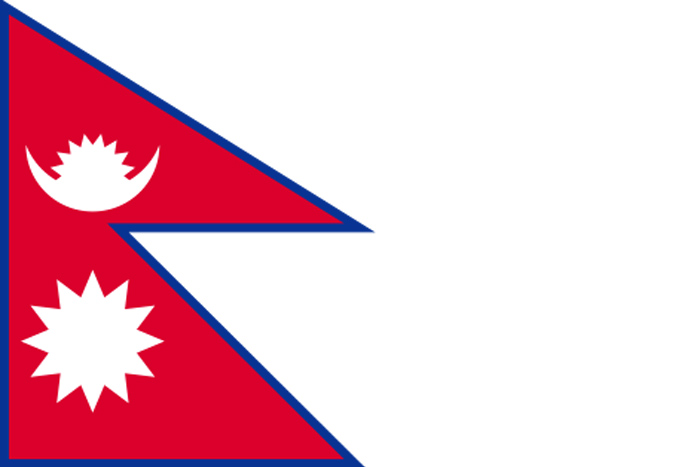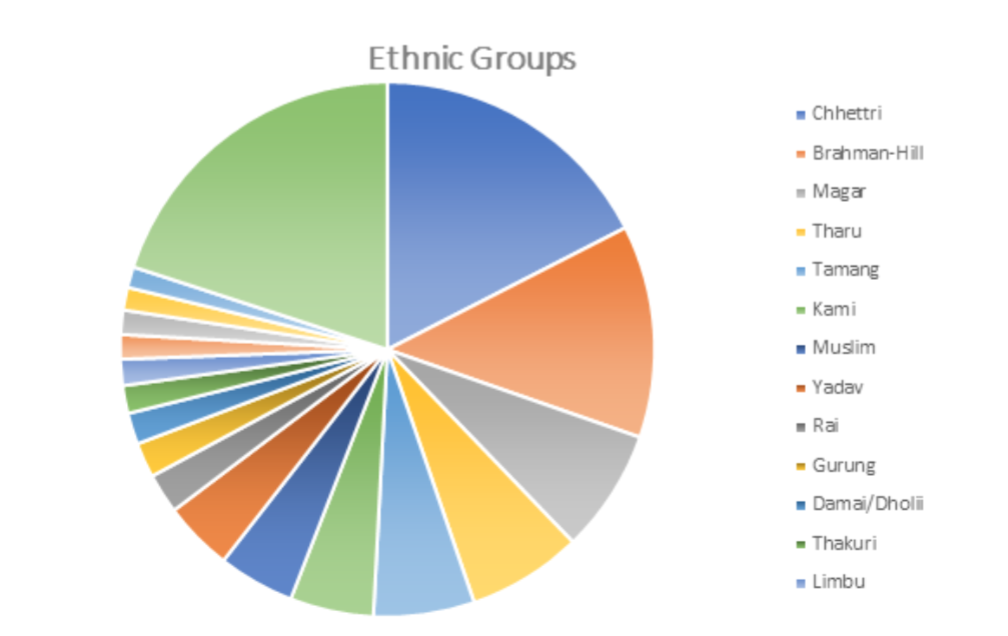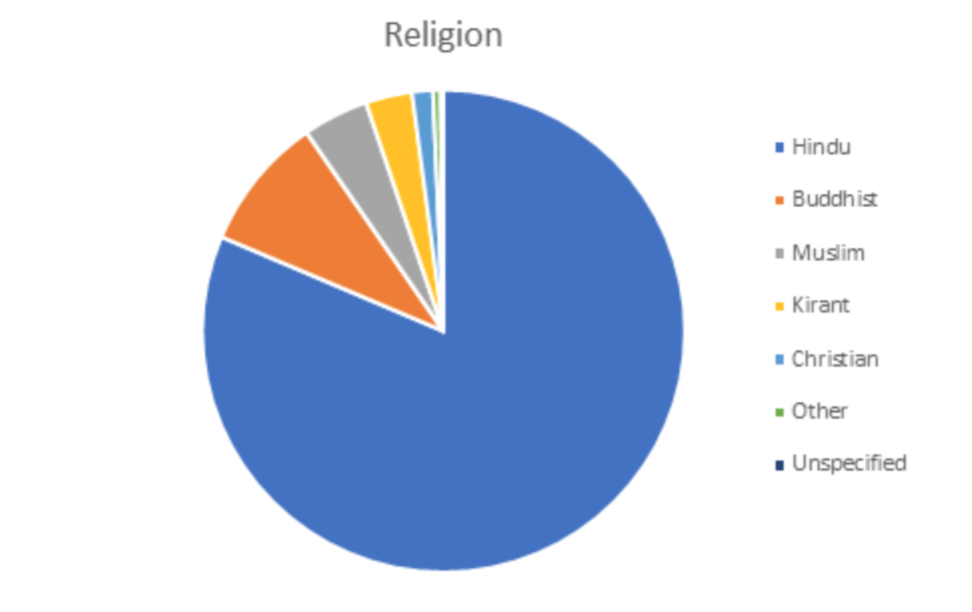GENERAL INFORMATION
Here you can find some general information about Nepal, to give you a quick image of the country. This will only provide a brief summary of the most important things in Nepal. People who take an interest in the research can relate the outcomes with this general information to get a better overview of the country and be up to date right away.

Geography
The small country of Nepal is particularly known for its mountains and culture, but there is much more to it. Located in-between India and China and part of South-Asia, the country has a history of being landlocked, civil wars and monarchy killing.
As one of the world's poorer countries, Nepal's economy relies heavily on aid and tourism. A devastating earthquake in April 2015 killed thousands of people, flattened villages and reduced numerous heritage sites to ruin. Since then political infighting has delayed much of the reconstruction despite billions of dollars having been pledged.
Demography
Nepal has little over 30 million inhabitants in 2020, which is a lot more that the 7,5 million inhabitants in 1950. The country has a population growth rate of 0.98% (2020 est.) and a median age of 25.3 years. In 2020, the female median age is approximately 27 years old and the male median age is approximately 24 years old. Only 5,7% of the population is estimated to be more than 65 years old, 66% of the population is between 15 and 64 years old, and 28.36% is younger than 14 years.
The birth rate is estimated to be 18.1 births per 1,000 people (2020 est.). Mother's median age when giving birth is 20.8 years old. The estimated fertility rate is 1.96 children born per woman. There is an infant mortality rate of 25.1 deaths per 1,000 live births. 26% of the infants under 5 is underweight. Life expectancy at birth is estimated to be 72.6 years for females and 71.1 years for males. The mortality rate is estimated to be 5.7 deaths/1,000 population (2020 est.).
Net migration rate is estimated to be 61 migrants per 100,000 people. The literacy rate in Nepal is estimated at approximately 59.7% for woman and approximately 78.6% for men. The physicians density is approximately 0.65 physicians/1,000 population (2017 est.) and a hospital bed density of approximately 3 beds per 1,000 people (est. 2012). Only 62% (est. 2019) of the Nepalese population has access to basic sanitation and 82% has access to safe drinking water (Rose, Zuberi, Karan, & Proud, 2020).
Culture
There are many ethnic groups in Nepal, in 2011 there were 125 different groups identified in a national census. The following graph represents the most known ethnic groups:

Every part of Nepal has different customs and traditions. The capital Kathmandu is known for its many cultures blending to form a national identity. The capital has served as the country's cultural metropolis since the unification of Nepal in the 18th century. The year round festivals add color to the lives of the Nepalis, which they celebrate with much festivities, splendor and ceremony. Also food is an important aspect in the celebration of these festivals.
The diversity of ethnicity in Nepal makes room for a variety of customs. Most of these customs have roots in the Hindu, Buddhist or other religions traditions. One of these traditions is around the rules of marriage. In Nepal a traditional marriage is arranged by parents and the boy or girl is of young age.
Another prominent law in Nepal is the illegalization of the slaughter of cows. The cow is considered a universal mother symbolizing motherhood, charity and pity. An important component of Hinduism, Buddhism and Jainism is Ahimsa, which in Sanskrit literally means 'non-violence'. The many temples in Nepal, have the custom of removing shoes, so the pure insides of the temple are not polluted. In some temples, non-Hindu's are prohibited from entering. A person's right hand is considered pure and is used for eating, paying, giving and receiving.
Food customs have been influenced by Indian and Tibetan styles of cooking, which cause customs to differ from region to region. The regular Nepali meal is daal (lentil soup), bhat (boiled rice) and takari (curried vegetables), often accompanied by achar (pickle). Curried meat is considered for special occasions, but very popular among people. Momos (steamed or fried dumplings) are one of the most popular snacks among the Nepalis. Finally rotis (flat bread) and dhedo (boiled flour) are also known as the staple diet in some homes (Rose, Zuberi, Karan, & Proud, 2020).
Language
There are many living languages in Nepal, in 2011 there were 123 different languages identified in a national census. Nepali language, also called Gurkha, Gorkhali, Gurkhali, or Khaskura, member of the Pahari subgroup of the Indo-Aryan group of the Indo-Iranian division of the Indo-European languages. Nepali is spoken by more than 17 million people, mostly in Nepal and neighbouring parts of India. Smaller speech communities exist in Bhutan, Brunei, and Myanmar.
Nepali includes three regional dialect groups: the western, the central, and the eastern. There is also a distinct dialect used by the members of the royal family and the upper classes. This dialect has a special lexicon and a four-level honorific system, and it is increasingly being adopted by the educated middle class and the newly wealthy (Kureel, 2019).

Beliefs/religion
Nepal declared that it was not connected with religious or spiritual matters by the parliament on May 18, 2006. Religions that are mainly practiced in Nepal are: Hinduism, Buddhism, Islam, Christianity, Jainism, Sikhism, Bon, ancestor worship and animism. The majority of Nepalis are either Hindus or Buddhists and these two religions have co-existed in harmony through centuries.

Hinduism is the most prominent religion of Nepal. Sanatan Dharma (eternal religion) is another name that is used and it is said that the religion excited before the human civilization. The majority of the ruling dynasty of Nepal were Hindu, so Hinduism is well practiced and common among the population. Hindu festivals like Dashain, Tihar, Gia Jatra and Holi are celebrated throughout the nation. Hinduism is a polytheistic religion, which means that there are several million deities. Each deity has its own importance and is linked to a specific act or ceremony. People choose their deities they worship daily, but it is tradition to worship several deities at a time. The worshipping is expressed in the offering of food, flowers and other gifts. Another way to worship is singing prayers to specific gods, known as Bhajans.
Buddhism is the second most practiced religion in Nepal. It is about the inner journey and the way to connect oneself to the reality. Buddhism focuses on the physical and spiritual balance of a person. The religion is a diverse religion by itself, between its disciples there are many different variations. The religion has two roots: Hinayana and Mahayana. Hinayana focuses on the teachings of Buddha, and the Mahayana focus on worshipping deities and achieving enlightenment by following them as examples. However, the core of the religion is the same. The roots of Buddhism are also found intertwined with Hinduism. Many religious places like Muktinath and Swayambhunath are important to both Hindus and Buddhists (Naskar, 2019).
Income/economy
Nepal is among the least developed countries in the world, with about one-quarter of its population living below the poverty line. The economy is heavily dependent on imports of basic materials and on foreign markets for its forest and agricultural products. Nepal imports essential commodities, such as
fuel, construction materials, fertilizers, metals, and most consumer goods, and exports such products as rice, jute, timber, and textiles.
The political and administrative system of Nepal has not made those changes in trade, investment, and related economic policies that would improve economic development and attract foreign capital. The government's development programs, which are funded by foreign aid, also have failed to respond directly to the needs of rural people.
Massive earthquakes struck Nepal in early 2015, which damaged or destroyed infrastructure and homes and set back economic development. Although political gridlock and lack of capacity have hindered post-earthquake recovery, government-led reconstruction efforts have progressively picked up speed, although many hard hit areas still have seen little assistance. Additional challenges to Nepal's growth include its landlocked geographic location, inconsistent electricity supply, and underdeveloped transportation infrastructure.
Nepal's mineral resources are limited and barley made. There are several known resources in Nepal, such as coal, iron ore, magnesite, copper, cobalt, limestone and mica. The river system of Nepal is immense and could have potential for hydroelectric development. If developed and used in Nepal and exported India, it could become Nepal's main source of income.
Agriculture-primarily rice, corn (maize), and wheat- is the main source of income for most of Nepal's population and accounts for well over half of the country's export earnings. Yet agricultural productivity is very low. The low harvests result from shortages of fertilizers and improved seed and from the use of inefficient techniques.
Nepal's land is forested for a total of one-third and a majority of this land is owned by the state. Poor management and overcutting cause problems, but is spite of this, timber is one of Nepal's most valuable resources and could have potential for more income Almost all timber is exported to India.
A small but expanding source of income is tourism. Foreign tourism is primarily confined to the Kāthmāndu Valley, which is the only area that has the needed hotels, food supplies, roads, and international transport services. There are, however, many areas outside the Kāthmāndu Valley with potential for the development of tourism; these include Pokharā, the Mount Everest area, and the Nārāyani area (where big game exists) (Central Intelligence Agency, 2020).
Politics
The politics of Nepal functions within the framework of a parliamentary republic with a multi-party system. Executive power is exercised by the Prime Minister and his/her cabinet, while legislative power is vested in the Parliament.
It has four political parties recognized in the federal parliament: Nepal Communist Party (NCP), Nepali Congress (NC), Samajbadi Party Nepal (SPN) and Rastriya Janata Party Nepal (RJPN). While all major parties officially espouse democratic socialism, NCP is considered leftist while Nepali Congress is considered centrist, with most considering it center-left and some center-right.
The constitution provided for a transitional period during which three sets of elections - local, provincial, and national - needed to take place. The first local elections in 20 years occurred in three phases between May and September 2017, and state and federal elections proceeded in two phases in November and December 2017. The parties headed by OLI and DAHAL ran in coalition and swept the parliamentary elections, and OLI, who led the larger of the two parties, was sworn in as prime minister in February 2018. In May 2018, OLI and DAHAL announced the merger of their parties - the
UML and CPN-M - to establish the Nepal Communist Party (NCP), which is now the ruling party in Parliament.
Leaders of Nepal
President: Bidhya Devi Bhandari

Bidhya Devi Bhandari was elected as Nepal's first woman president in a parliamentary vote in October 2015. She was deputy leader of the Maoist Communist Party of Nepal Unified Marxist-Leninist (CPN-UML) and a former defence minister.
She is a campaigner for women's rights and widow of late communist leader Madan Kumar Bhandari. The presidential position is mainly ceremonial.
Prime minister: Khadga Prasad Sharma Oli

Communist Party of Nepal Chairman Khadga Prasad Sharma Oli was sworn in in February 2018, having previously served as prime minister in 2015-16.
An alliance of Oli's party and former Maoist rebels trounced the incumbent Nepali Congress party in 2017 polls. Mr. Oli heads the first government elected under a new national constitution, cementing
An alliance of Oli's party and former Maoist rebels trounced the incumbent Nepali Congress party in 2017 polls. Mr. Oli heads the first government elected under a new national constitution, cementing Nepal's transformation from Hindu monarchy to a federal republic. He has promised to promote peace, stability and development in one of the world's poorest countries. During Oli's last term in office in 2015, relations between Kathmandu and its traditional ally Delhi soured after protests over the constitution led to a blockade of the Nepal-India border. His government is considered to be closer to China than India, with investment from China likely to be sought for a long-mooted Himalayan rail link and energy-starved Nepal's hydropower system (Rose, Zuberi, Karan, & Proud, 2020)
History
The first mentioned rules were the Gopalas and Mahishapalas beliefs with their capital at Matatirtha, the south-west corner of the Kathmandu Valley. In 1200 A.D the Mallas arrived. During their 550 year rule, the Mallas built a number of temples and splendid palaces with picturesque squares.
The community and cities became well organized during the malas ruling and religious festivals were introduced and there was encouragement of literature, music and art. After the death of Yaksha Malla, the land was divided into three kingdoms: Kathmandu (Kantipur), Bhaktapur (Bhadgaon) and Patan (Lalitpur). Around this time, the Nepal as we know it today was divided into about 46 independent principalities. One of these principalities was the kingdom of Gorkha with a Shah ruler.
An ambitious Gorkha King named Prithvi Narayan Shah started a war that led to the defeat of all the kingdoms in the land by 1769. Prithvi Narayan decided to move his capital to Kathmandu establishing the Shah dynasty which ruled unified Nepal from 1769 to 2008.
In the 17th and 18th centuries, the Shah dynasty expanded their territory. Prithvi Narayan had a mission to conquer the entire Kathmandu valley. There was a threat of the British Raj in India, but Prithvi declined the missionaries from England. This resulted in a more than 100 year land lockdown for Nepal to the outside world.
In the midst of the 19th century Rana prime ministers were appointed, but these positions were mere for show and gave the king absolute power. In the 1950s the Rana's were abdicated and a democratic movement started with the support of the king. in 1959, a new constitution was issued and the first democratic elections were held. A democratic government was formed with a new prime minister, but one year later the king changed its mind and abdicated this form over governing.
In 1990 a people's movement started as a result of the many years of struggle without political parties. With the king as head of the state and a prime minister, there was a multiparty parliament established. In February 1996 Maoist parties declared people's war against the monarchy and the government.
Then on 1st June 2001, the king's son committed a horrific massacre by killing the entire royal family including his father and mother King Birendra and Queen Aishwarya and many of their closest relatives. With only King Birendra's brother, Gyanendra and his family surviving, he was crowned the king. King Gyanendra abided by the elected.
On May 28, 2008, the newly elected Constituent Assembly declared Nepal a Federal Democratic Republic, abolishing the 240 year-old monarchy. Nepal today has a President as Head of State and a Prime Minister heading the Government.
In April 2015 a devastating earthquake with many aftershocks hit Nepal resulting in many deaths and damaging buildings and property on an unimaginable scale. Most mid hill districts of Nepal including Kathmandu valley saw massive devastation. the earthquake caused the entire government to prioritize their efforts to the rebuilding and recovering post disaster (Government of Nepal, 2016).
Sources
Central Intelligence Agency. (2020, June 10). The world Factbook : South Asia : Nepal . Retrieved June 12, 2020, from https://www.cia.gov/library/publications/the-world-factbook/geos/np.html
Government of Nepal . (2016, January 31). History Of Nepal. Retrieved June 12, 2020, from https://mofa.gov.np/about-nepal/history-of-nepal/
Kureel, P. (2019, October 22). Languages of Nepal - A Traveller's Guide To Go Local & Feel Welcomed! Retrieved June 12, 2020, from https://www.holidify.com/pages/language-of-nepal-1087.html
Naskar, S. (2019, August 20). Religions in Nepal - The Repository of Ethnic Mosaic. Retrieved June 12, 2020, from https://www.holidify.com/pages/religion-in-nepal-855.html
Reuters . (2015, October 29). Bidhya Devi Bhandari elected Nepal's first female president [Photograph]. Retrieved from https://www.bbc.com/news/world-asia-34664430
Rose, L. E., Zuberi, M., Karan, P. P., & Proud, R. R. (2020, June 5). Nepal | Culture, History, & People. Retrieved June 12, 2020, from https://www.britannica.com/place/Nepal
Siddiqui, M. (2018, February 15). Khadga Prasad Sharma Oli Become New PM of Nepal. Retrieved June 12, 2020, from https://abbtakk.tv/en/403762-2khadga-prasad-sharma-oli-become-new-pm-of-nepal/
Virgin Trails Pvt. Ltd. (n.d.). Political System of Nepal. Retrieved June 12, 2020, from https://virgintrails.com/about-nepal/political-system/